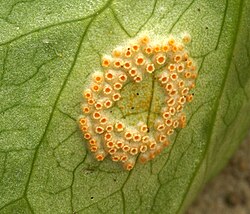Top Qs
Timeline
Chat
Perspective
Pucciniomycetes
Class of fungi From Wikipedia, the free encyclopedia
Remove ads
Pucciniomycetes (formerly known as Urediniomycetidae) is a diverse class of fungi in the subphylum Pucciniomycotina of phylum Basidiomycota.[3] The class contains 5 orders, 21 families, 190 genera, and approximately 8,016 species.[4] It has been estimated that this class contains about one third of all teleomorphic basidiomycetes. Pucciniomycetes contains many economically important plant pathogenic fungal rusts; the order Pucciniales (formerly Uredinales) is the largest clade in this class, representing approximately 7,000 species.[5]
Pucciniomycetes are cosmopolitan and can be found in both terrestrial and aquatic environments, although aquatic species are poorly understood.[5]
Remove ads
Characteristics
Species in the class Pucciniomycetes develop no basidiocarp, karyogamy occurs in a thick-walled resting spore (teliospore), and meiosis occurs upon germination of the teliospore. They have simple septal pores without membrane caps, and disc-like spindle pole bodies. Except for a few species, the basidia, when present, are transversely septate. Mannose is the major cell-wall carbohydrate; glucose, fucose, and rhamnose are the less prevalent neutral sugars; and xylose is not present.
Remove ads
Taxonomy
The class Pucciniomycetes was first defined as a monophyletic group in 1995. Pucciniomycetes contains rust fungi, the order Septobasidiales, teliospore-forming yeasts, and various species that were once classified as smut or jelly fungi.[5]
References
Wikiwand - on
Seamless Wikipedia browsing. On steroids.
Remove ads

